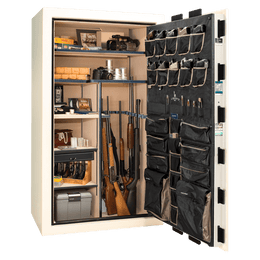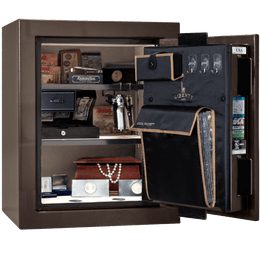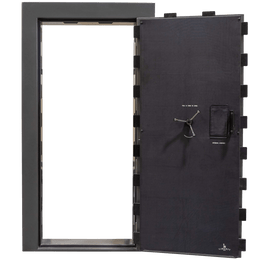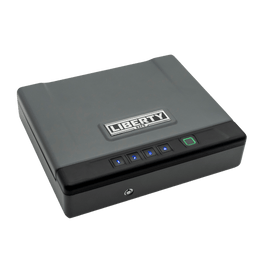Understanding Your True Protection Needs
When you invest in a safe, you're investing in peace of mind. The primary goal is to protect your most important possessions—from firearms and family heirlooms to critical documents and digital media—from unforeseen disasters. The two most common threats that come to mind are fire and water. While these dangers seem straightforward, the technology and terminology behind protecting against them can be complex. Understanding the difference between fire-resistant and waterproof safes is the first step toward making a truly informed decision that safeguards what you value most.
As seasons change, so do the risks. Autumn can bring hurricanes and heavy rains, while winter carries the threat of burst pipes. And unfortunately, house fires are a year-round hazard. This guide will clarify the distinctions, helping you choose the right level of security for your specific needs in the United States.
The Threat of Fire: What "Fire-Resistant" Really Means
No consumer-grade safe is truly "fireproof"—they are fire-resistant. This means they are engineered to withstand specific temperatures for a set duration while keeping the internal temperature below a critical point. For paper documents, that point is 350°F (177°C), as paper begins to char and ignite around 405°F.
A safe's fire rating is typically expressed in minutes, such as 60, 75, 90, or even 120 minutes, at a given external temperature (e.g., 1200°F). This rating signifies that the safe's interior will not exceed 350°F during that time frame under test conditions. When choosing, consider your local fire department’s average response time. A home in a rural area may require a safe with a longer fire rating than one in a dense urban center.
This resilience is achieved through advanced construction, including multiple layers of fire-activated gypsum fireboard and specialized door seals. A high-quality intumescent seal, for example, will expand when exposed to heat, sealing the door to block out flames, smoke, and even water from firehoses. Having fire protection you can trust is non-negotiable. Safes like the Colonial Series offer excellent 75-minute protection, while models like the Classic Plus provide an impressive 110 minutes of certified fire resistance.
The Unseen Danger: Understanding Water Protection
Water damage is often an overlooked but equally devastating threat. It doesn't just come from major floods. A burst pipe, a malfunctioning appliance, or the water used to extinguish a fire can all lead to significant damage. A safe's ability to resist water is determined by its construction and, most importantly, its door seal.
Unlike fire ratings, standards for "waterproof" can vary. Some safes are rated for full submersion at a certain depth for a specific period, while others are rated as "water-resistant," meaning they can withstand spray from fire hoses or minor leaks. The key is a tight, secure seal that prevents moisture from seeping in. This not only protects against catastrophic water events but also shields your valuables from ambient humidity, which can cause rust on firearms and mildew on documents over time.
At a Glance: Fire vs. Water Protection
| Feature | Fire-Resistant Safes | Water-Resistant Safes |
|---|---|---|
| Primary Goal | Protects contents from extreme heat and smoke. | Protects contents from floods, leaks, and firefighting spray. |
| Key Technology | Layered fireboard insulation and heat-activated door seals. | Waterproof gaskets and a solid, pressure-sealed door. |
| Best For | Protecting paper, cash, and digital media from fire damage. | Homes in flood-prone areas or placement in basements. |
| Crucial Benefit | Fortunately, you don't have to choose. A top-tier safe from a reputable manufacturer offers combined protection. The same advanced seals that block heat and smoke are also highly effective at keeping water out, giving you comprehensive security. | |
Assessing Your Environmental Risks Across the US
Your geographical location plays a huge role in determining your primary security needs. While every home in the United States needs fire protection, some regions face higher risks of water damage.
- Southeast & Gulf Coast: Hurricane season makes robust water protection a top priority alongside a high fire rating.
- West Coast & Mountain West: Wildfire threats demand a superior fire rating. The subsequent risk of mudslides or flash floods in burn scar areas also makes water resistance important.
- Midwest & Northeast: Severe thunderstorms, tornadoes, and winter blizzards that can cause burst pipes mean that water protection is a critical feature.
Ultimately, a safe that provides both certified fire protection for gun and home safes and reliable water resistance offers the most complete defense. Instead of choosing one over the other, focus on finding a safe with excellent ratings for both. If you're unsure where to start, taking a quiz to find your perfect safe can help narrow down the options based on your unique situation.
Ready to Secure Your Valuables?
Choosing the right safe is a critical decision. At Liberty Safe, we've helped over two million Americans protect what matters most. Our experts are here to help you understand your options and find the perfect balance of fire and water protection.
Contact Our ExpertsFrequently Asked Questions (FAQ)
What is a good fire rating for a home safe?
We recommend a minimum of 60 minutes of fire protection for most homes. This provides a solid buffer for fire department response and firefighting efforts. For those in rural areas or with highly valuable collections, 90 minutes or more is ideal.
How can I be sure a safe is water-resistant?
Look for safes with a high-quality, continuous door seal rather than a simple weather stripping. Leading manufacturers often test their safes against water spray to simulate fire hoses. Check the product specifications for any stated water protection ratings.
Where is the best place to install a safe for both fire and water protection?
A main-level interior closet bolted securely to a concrete slab foundation is often the best compromise. Basements are cooler in a fire but are the first place to flood. Garages can experience extreme temperature and humidity swings. Always have your safe professionally installed and bolted down for maximum security.
Do I still need a dehumidifier in a water-resistant safe?
Yes. While a good seal prevents liquid water from entering, it can also trap ambient moisture inside. A dehumidifier is a small investment that protects firearms from rust and documents from mildew, especially in humid climates.







